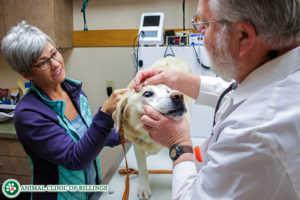Animal Cancer – Symptoms, Diagnosis and Treatment
 At the Animal Clinic of Billings, we understand that your dog is not just a pet, but a very cherished and beloved member of the family. The mutual love we share with our furry family members can make a cancer diagnosis very difficult to hear.
At the Animal Clinic of Billings, we understand that your dog is not just a pet, but a very cherished and beloved member of the family. The mutual love we share with our furry family members can make a cancer diagnosis very difficult to hear.
Our veterinarians and support staff have been there themselves and are trained to address both the emotional and physical aspects of canine cancer diagnosis and treatment with compassion and empathy.
What is cancer?
Cancer is the abnormal uncontrolled growth and replication of cells that can originate in any type of tissue within the body and may spread via the circulatory and lymphatic systems to other parts of a dog’s body.
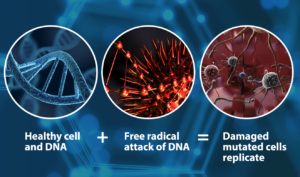
Cancer is the most common cause of death in dogs 10 years of age and older. It is estimated that approximately one in four dogs, one in five cats, and one in three people will develop cancer at some point in their lives. Although cancer was at one time considered a uniformly fatal diagnosis in dogs, today most cancers are treatable and, in some cases, curable due to modern advances in veterinary medicine. As with most disease processes, treatment will be most effective if cancer is detected in its earliest stages. Semi-annual wellness examinations and lab work provide the best chance to find cancer early, and are especially critical in senior dogs, who are at an elevated risk of developing cancer.
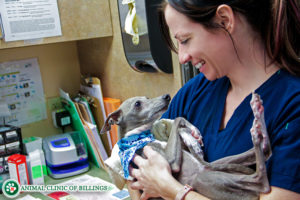 If you find a lump, swelling, or other physical abnormality and suspect your dog may have cancer, please contact us immediately to schedule an appointment with one of our veterinarians. We are here to help guide you and your dog through the cancer diagnosis process and will work to develop the best possible treatment plan for your dog’s individualized needs. Our veterinarians will provide you with all of your options to effectively, humanely, and successfully deal with canine cancer.
If you find a lump, swelling, or other physical abnormality and suspect your dog may have cancer, please contact us immediately to schedule an appointment with one of our veterinarians. We are here to help guide you and your dog through the cancer diagnosis process and will work to develop the best possible treatment plan for your dog’s individualized needs. Our veterinarians will provide you with all of your options to effectively, humanely, and successfully deal with canine cancer.
406-252-9499
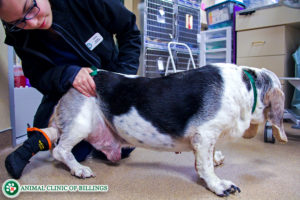 COMMON TYPES OF CANCER IN DOGS
COMMON TYPES OF CANCER IN DOGS
The most common types of cancer we see in dogs include:
Mast Cell Tumors
Mast cell tumors are the most common type of skin tumors found on dogs, but they can also affect other parts of the body, such as the liver, bones, and spleen. MCTs are a cancer of a specific type of immune cell called a mast cell. Mast cells normally function to help defend the body against parasitic invaders, and also play an integral role in allergic diseases.
Mast cell tumors are most commonly seen as a raised lump or bump on or underneath a dog’s skin that may become red, swollen, or ulcerated. MCT’s can vary widely in appearance and range from relatively benign to extremely dangerous.
Certain dog breeds are at an increased risk for developing mast cell tumors, including most brachycephalic or flat-faced breeds (Pugs, Bulldogs, Boston Terriers, and Boxers), Shar Peis, Staffordshire Terriers, Rhodesian Ridgebacks, and Retrievers, but all breeds and mixes have the potential to develop a mast cell tumor.
Typically, treatment involves surgical removal of the mass followed by evaluation of the mass by a pathologist, who will determine whether the MCT is low grade or high grade. Usually, low grade MCTs are cured by surgical removal. High grade MCTs, however, have a high risk of metastasis to other areas of the body, and typically require chemotherapy for the best outcome.
Hemangiosarcoma
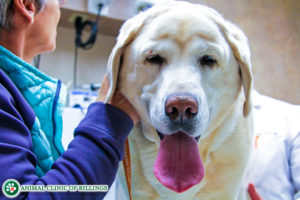 Hemangiosarcoma is a cancer of cells that make up the inner lining of blood vessels. It tends to behave very aggressively, and often has already metastasized at the time of diagnosis. Hemangiosarcomas are most commonly seen in middle-aged or elderly dogs, but can occur at any age.
Hemangiosarcoma is a cancer of cells that make up the inner lining of blood vessels. It tends to behave very aggressively, and often has already metastasized at the time of diagnosis. Hemangiosarcomas are most commonly seen in middle-aged or elderly dogs, but can occur at any age.
Dog breeds with the highest risk of hemangiosarcoma include Golden Retrievers, Labrador Retrievers, and German Shepherds. These tumors most commonly originate in the spleen, heart, and liver, and frequently metastasize to the lungs, liver, and other abdominal organs. Usually symptoms such as lethargy and weight loss do not become apparent until the cancer has already spread throughout the body, making the prognosis poor.
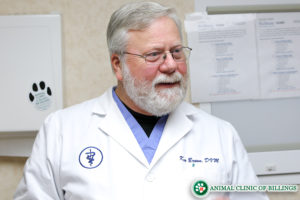 Additionally, because this is a tumor of blood vessel cells, it is at risk of spontaneous hemorrhage, and in some cases, the first sign of this cancer is collapse from severe internal bleeding.
Additionally, because this is a tumor of blood vessel cells, it is at risk of spontaneous hemorrhage, and in some cases, the first sign of this cancer is collapse from severe internal bleeding.
We recommend additional cancer screening with one of our veterinarians for predisposed breeds once they reach the age of 5 years old.
Lymphoma
Lymphoma is a cancer of immune cells called lymphocytes. This common form of cancer in dogs can affect dogs of any age or breed, but Golden Retrievers, Boxers, German Shepherds, and Beagles may be at increased risk.
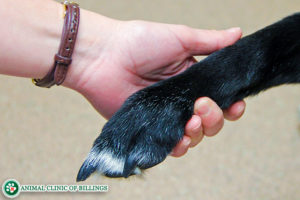 Signs of lymphoma may include swollen lymph nodes (behind a dog’s jaw, behind the knee, or in front of the dogs’ shoulders), inappetence, weight loss, and lethargy. In addition to lymph nodes, lymphoma often also infiltrates internal organ systems such as the liver, spleen, GI tract, kidneys, central nervous system, and bone marrow.
Signs of lymphoma may include swollen lymph nodes (behind a dog’s jaw, behind the knee, or in front of the dogs’ shoulders), inappetence, weight loss, and lethargy. In addition to lymph nodes, lymphoma often also infiltrates internal organ systems such as the liver, spleen, GI tract, kidneys, central nervous system, and bone marrow.
The prognosis for lymphoma varies widely, depending on the type and stage of disease. Some types of lymphoma can be successfully managed with medication for extended periods of time, while others can be highly resistant to treatment and carry a poor prognosis.
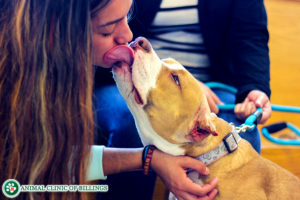 Melanoma
Melanoma
Melanoma is a type of cancer that originates from pigment cells (melanocytes) found in the skin, oral mucosa, and eyes. While all dogs are at risk of melanoma, Scottish Terriers, Schnauzers, Irish Setters, Golden Retrievers, Doberman Pinschers, and Rottweilers are predisposed.
A melanoma usually appears as a dark brown or black mass, although some melanomas are non-pigmented. Most melanomas in dogs are benign and can be cured with surgical removal. Melanomas that grow in the mouth, along the lip margins, or on a dog’s toes are more likely to be malignant. While they cannot be cured, several treatment options exist to slow the progression of malignant melanomas.
Osteosarcoma
Osteosarcoma, a malignant form of bone cancer, is the most common type of primary bone cancer in dogs. Although osteosarcoma is most commonly encountered in large and giant breed dogs, it can develop in dogs of any size or breed. An affected dog will exhibit lameness, pain, and swelling at the site of the tumor.
Osteosarcomas have almost always metastasized by the time they are diagnosed. Treatment requires surgical amputation of the dog’s affected limb followed by chemotherapy. While only a small percentage of dogs survive long-term, treatment can significantly improve quality of life.
Bladder Cancer
The most common type of urinary or bladder cancer is called Transitional Cell Carcinoma (TCC). This is a cancer of the cells lining the bladder and urinary tract. Scottish Terriers, West Highland White Terriers, Fox Terriers, Beagles, and Shetland Sheepdogs are at an elevated risk of developing TCCs.
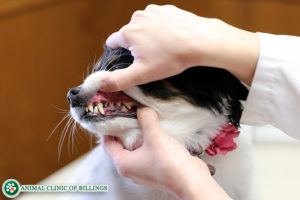 TCCs are often malignant, with spread to the abdominal lymph nodes, liver, lungs, and bones. The most common symptoms of a TCC are straining to urinate and blood in the urine. This type of tumor generally cannot be cured, but treatment has the potential to extend survival with good quality of life from only a couple of months to a year or more.
TCCs are often malignant, with spread to the abdominal lymph nodes, liver, lungs, and bones. The most common symptoms of a TCC are straining to urinate and blood in the urine. This type of tumor generally cannot be cured, but treatment has the potential to extend survival with good quality of life from only a couple of months to a year or more.
Mouth and Nose Cancer
Cancers of the mouth are common in dogs, while those found in the nose are relatively uncommon. Most oral and nasal cancers in dogs are malignant. Symptoms of oral tumors in dogs include bad breath, drooling, dropping food from the mouth, difficulty swallowing, bleeding from the mouth, and a visible swelling or mass within the mouth.
Symptoms of nasal tumors include nasal discharge, sneezing, nosebleeds, noisy breathing, and facial swelling. Because of their aggressive behavior and proximity to important structures, these tumors are often difficult to manage; the earlier they are diagnosed, the better the odds that aggressive treatment will extend a dog’s survival with good quality of life.
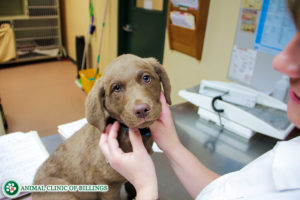
Mammary Carcinoma
All female dogs are at risk of mammary carcinoma, but sexually intact female dogs are at an especially high risk of developing malignant mammary tumors. This is one reason why spaying your dog, ideally before their first heat cycle, is so important.
It’s estimated that approximately 50% of mammary tumors are malignant. Mammary tumors usually appear as single or multiple firm lumps under the skin in the area of one or more of the dog’s mammary glands. If a mammary tumor is not malignant or has not yet metastasized in a dog, then surgical removal will be curative.
Brain Tumors
Symptoms of a brain tumor in dogs include behavioral changes, seizures, pacing, circling, and difficulty walking. In dogs, the risk of brain tumors increases with advancing age, and Golden Retrievers, Boxers, French Bulldogs, Boston Terriers, and Rat Terriers have an elevated risk of developing brain tumors.
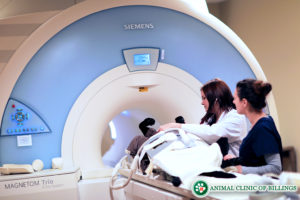 An MRI or CT scan is necessary to diagnose a brain tumor and determine its location and size. Chemotherapy and radiation therapy can sometimes help to control inoperable brain tumors, and if the tumor is operable, surgical intervention may be recommended by your veterinarian.
An MRI or CT scan is necessary to diagnose a brain tumor and determine its location and size. Chemotherapy and radiation therapy can sometimes help to control inoperable brain tumors, and if the tumor is operable, surgical intervention may be recommended by your veterinarian.
Testicular cancer
Testicular cancer is a form of cancer that commonly affects un-neutered (sexually intact) dogs. Testicular cancer is extremely easy to prevent with neutering, and if detected and arrested early, is often curable with surgery.
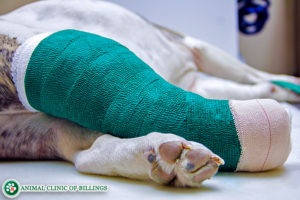 Histiocytic Sarcoma
Histiocytic Sarcoma
Histiocytic Sarcoma is a cancer of histiocytes, immunological cells originating in the bone marrow. It is most common in middle-aged to older dogs, and Bernese Mountain Dogs, Retriever breeds, Rottweilers, Mini Schnauzers, and Pembroke Welsh Corgis are at elevated risk.
Symptoms of histiocytic sarcoma in dogs depend on the part of the body that is affected, and may include swelling of a limb, lameness, lymph node enlargement, cough, difficulty breathing, lethargy, inappetance, and weight loss. This type of cancer tends to progress rapidly, and is typically not very responsive to treatment.
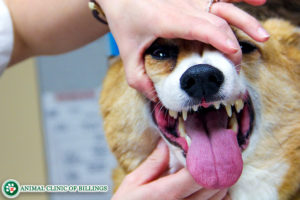 Squamous Cell Carcinomas
Squamous Cell Carcinomas
Squamous cell carcinoma (SCC) is a type of cancer in dogs that’s most commonly found on the skin and inside the mouth. Dogs with non-pigmented skin are at an elevated risk as their skin is more vulnerable to sun damage. SCC’s appear as non-pigmented masses on a dog’s skin or oral mucosa that may be ulcerated.
Early detection of squamous cell carcinomas and complete surgical removal is the most common and effective form of treatment. The behavior of this cancer is variable in dogs, with SCC’s inside the mouth and on the toes typically behaving most aggressively.
SYMPTOMS AND SIGNS OF CANCER IN DOGS
Spotting signs of cancer in dogs can sometimes be easy but is often relatively difficult, especially in the disease’s earliest stages. Signs and symptoms of cancer in dogs can vary significantly depending on the specific type of cancer, how advanced it is, and what other health conditions are present.
Some of the most common signs and symptoms a dog with cancer may exhibit include:
- Evidence of pain
- Abnormal odors emanating from the mouth or ears
- Abnormal discharge from the ears, eyes, mouth, or rectum
- Abdominal swelling
- Wounds or sores that won’t heal
- Sudden unexplained weight loss
- Coughing or difficulty breathing
- Lethargy or depression
- Change in appetite
- Changes in bathroom habits
- Lumps, bumps, or swellings underneath a dog’s skin
WHAT TO KNOW ABOUT TUMORS IN DOGS
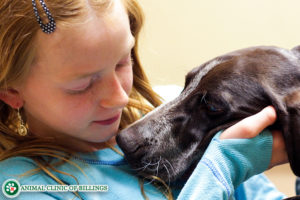 Superficial tumors typically appear on dogs as a lump within or beneath the skin. Many other tumors are internal and can’t be seen. Early detection and treatment are imperative to preserving your dog’s health and quality of life. We cannot over-stress the importance of regular wellness examinations to allow your veterinarian to inspect your canine companion for abnormalities that may indicate the presence of cancer. Due to the increased risk of cancer with advancing age, it is especially important for dogs 7 years of age and older to maintain a consistent semi-annual appointment schedule with their veterinarian.
Superficial tumors typically appear on dogs as a lump within or beneath the skin. Many other tumors are internal and can’t be seen. Early detection and treatment are imperative to preserving your dog’s health and quality of life. We cannot over-stress the importance of regular wellness examinations to allow your veterinarian to inspect your canine companion for abnormalities that may indicate the presence of cancer. Due to the increased risk of cancer with advancing age, it is especially important for dogs 7 years of age and older to maintain a consistent semi-annual appointment schedule with their veterinarian.
If you feel a lump or swelling on any part of your dog’s body, call to schedule an appointment with your veterinarian immediately.
TREATMENT OPTIONS FOR DOGS WITH CANCER
SURGERY
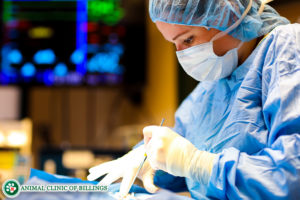 Surgery has long been considered the first and best chance of a cure in many cancers. If certain cancers are found early enough, before they grow too large or have had a chance to spread to other parts of the body, surgery can eradicate them. Surgery also has the potential to reduce pain, improve quality of life, and prolong life when a cure is not possible. Surgery is often combined with chemotherapy or radiation therapy to cure or slow the progression of a cancer.
Surgery has long been considered the first and best chance of a cure in many cancers. If certain cancers are found early enough, before they grow too large or have had a chance to spread to other parts of the body, surgery can eradicate them. Surgery also has the potential to reduce pain, improve quality of life, and prolong life when a cure is not possible. Surgery is often combined with chemotherapy or radiation therapy to cure or slow the progression of a cancer.
RADIATION THERAPY
Radiation therapy for pets is not readily available outside of large cities and veterinary university hospitals but can be useful in the treatment of many types of cancer and has the potential to be very effective. The treatment uses energy similar to that used to make x-rays, but it is many times stronger and is focused precisely on the tumor to spare neighboring normal tissues.
This large focused dose of radiation is lethal to all cells in the treatment field. Radiation therapy, like surgery, can be curative or can shrink a tumor to help alleviate pain and improve quality of life. Radiation therapy is generally available at veterinary universities’ teaching hospitals and veterinary specialty hospitals in large metropolitan areas.
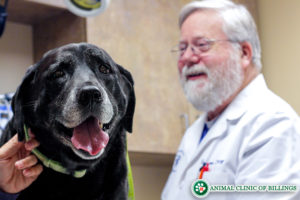
CHEMOTHERAPY
Chemotherapy is the use of medications that destroy cancer cells. There are many chemotherapy drugs and protocols available to veterinarians who provide these services. Some cancers in pets are only amenable to treatment with chemotherapy, while others are best treated with a combination of chemotherapy with surgery or radiation therapy.
The primary goal of chemotherapy in pets is to slow or stop the progression of cancer without causing a decrease in quality of life for the patient. Most everyone is aware of the possible side effects of chemotherapy in humans – particularly nausea and hair loss.
Fortunately, dogs and cats generally tolerate chemotherapy at the dosages used in veterinary medicine much better than do human patients on chemo. Most veterinary chemotherapy patients will not have to be hospitalized, and side effects can often be minimized or prevented to maintain the quality of life we want for our pets.
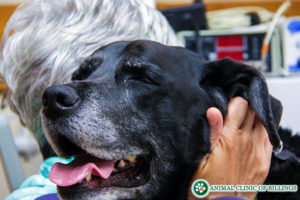
OTHER CANCER TREATMENTS
Immunotherapy is a new and promising approach to cancer treatment. Several cancer “vaccines” have been developed for veterinary patients, not to prevent cancer but to assist in treatment. There is currently a vaccine for lymphoma patients in remission following chemotherapy and a vaccine for oral melanoma in dogs that can aide in prolonging survival while preserving quality of life.
Adjunctive treatments include medications to alleviate certain symptoms of cancer, such as pain and nausea. Additionally, improved nutrition has shown to enhance the quality of life of veterinary cancer patients and has even extended pets’ life expectancy.
MAKE AN APPOINTMENT TODAY IF YOU SUSPECT CANCER IN YOUR DOG
If for any reason you suspect that your dog may have cancer, please call one of our receptionists to schedule an appointment with one of our veterinarians today. We understand how overwhelming the thought of your dog having cancer can be, but we are here to help you and your canine companion get through it by confidently and compassionately offering you and your dog the best veterinary care available.
406-252-9499 REQUEST AN APPOINTMENT


